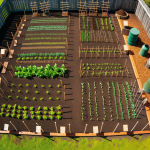Key Takeaway: How to build gardening boxes is a rewarding DIY project that can significantly enhance your gardening experience. With the right materials, tools, and techniques, you can create durable, customized raised beds that provide optimal growing conditions for your plants while saving your back and improving your garden’s aesthetics.
Introduction
As an avid gardener with over a decade of experience, I’ve learned that the foundation of a successful garden often lies in its infrastructure. One of the most game-changing additions to my garden was the introduction of raised beds. These elevated planting areas, also known as garden boxes, have revolutionized the way I grow vegetables, herbs, and flowers.
Raised garden boxes offer numerous benefits:
- Improved soil control
- Better drainage
- Extended growing season
- Easier access and reduced strain on your back
- Protection from pests
- Aesthetic appeal
In this comprehensive guide, I’ll walk you through the process of building your own garden boxes, drawing from my personal experience and the lessons I’ve learned along the way. Whether you’re a seasoned gardener looking to upgrade your growing space or a beginner eager to start your first vegetable patch, this article will equip you with the knowledge and confidence to create the perfect raised beds for your garden.
Materials Needed
Before we dive into the construction process, let’s gather all the necessary materials and tools. Having everything on hand before you start will make the building process smoother and more enjoyable.

Tools:
- Circular saw or hand saw
- Drill with drill bits and screwdriver bits
- Measuring tape
- Square
- Pencil
- Safety goggles and work gloves
- Shovel (for site preparation)
- Level
Materials:
- Lumber (Cedar, Redwood, or Douglas Fir are recommended)
- 4 boards for the sides (2×6 or 2×8, length depends on your desired box size)
- 4 corner posts (4×4, length depends on your desired box height)
- Exterior wood screws (3-inch)
- Landscaping fabric (optional, for lining the bottom)
- Hardware cloth (optional, for pest protection)
- Wood sealer or non-toxic paint (optional, for preserving the wood)
When choosing lumber, it’s important to select wood that is naturally resistant to rot and insects. Cedar and redwood are excellent choices, although they can be more expensive. Douglas fir is a more budget-friendly option that still offers good durability when properly treated.
Pro Tip: Avoid using pressure-treated lumber for vegetable gardens, as it may contain chemicals that can leach into the soil and potentially affect your plants. For more information on safe wood choices for garden boxes, check out this guide from the University of California.
Step-by-Step Guide
Now that we have our materials ready, let’s walk through the process of building your garden boxes step by step.
1. Planning and Measuring
The first step in creating your garden boxes is to decide on their size and location. Consider the following factors:
- Available space in your garden
- Types of plants you want to grow
- Your ability to reach the center of the bed (typically, 4 feet wide is the maximum for easy access from both sides)
- Sun exposure in different parts of your yard
- Proximity to a water source
Once you’ve determined the ideal location and size, measure and mark the area where you’ll place your garden box. Use stakes and string to outline the perimeter, ensuring your corners are square.
2. Cutting the Wood
With your measurements in hand, it’s time to cut your lumber to size. If you’re not comfortable using a circular saw, most hardware stores will cut the wood for you at the time of purchase.
For a standard 4×8 foot garden box, you’ll need:
- Two 8-foot long boards for the long sides
- Two 4-foot long boards for the short sides
- Four 4×4 posts cut to your desired height plus an additional 6 inches (for anchoring)
Safety First: Always wear safety goggles and work gloves when cutting wood. If you’re using power tools, follow all safety guidelines provided by the manufacturer.
3. Assembling the Frame
Now comes the exciting part – assembling your garden box! Here’s how to do it:
- Lay out your boards in the shape of your garden box, with the 4×4 posts at each corner.
- Starting with one of the long sides, attach the board to two corner posts. Pre-drill holes to prevent the wood from splitting, then secure with 3-inch exterior wood screws. Use two screws at each end.
- Repeat this process for the opposite long side.
- Attach the short sides in the same manner, securing them to the corner posts and the ends of the long sides.
- Check that your garden box is square by measuring diagonally from corner to corner. Both measurements should be equal. Adjust if necessary before final tightening of all screws.
4. Adding the Bottom (if necessary)
In most cases, you won’t need to add a solid bottom to your garden box. The open bottom allows for better drainage and permits plant roots to penetrate deeper into the native soil. However, if you’re building your box on a hard surface like concrete, or if you’re dealing with particularly aggressive burrowing pests, you might want to add a bottom.
To add a bottom:
- Cut hardware cloth to fit the inside dimensions of your box.
- Staple the hardware cloth to the bottom edges of your frame.
- If desired, add a layer of landscaping fabric over the hardware cloth to prevent soil from sifting through.
5. Reinforcing the Corners
For added stability, especially in larger or taller boxes, consider adding corner braces. You can create these by cutting 45-degree angles on short pieces of your 2×6 or 2×8 lumber and securing them in each inside corner of your box.
6. Adding Drainage Holes
Proper drainage is crucial for healthy plant growth. If you’ve added a solid bottom to your box, you’ll need to drill several drainage holes. Space them about 6 inches apart across the bottom of the box.
For boxes without a bottom, you can improve drainage by slightly elevating one end of the box. This gentle slope will encourage excess water to flow away from your plants’ roots.
7. Treating or Sealing the Wood (optional)
To extend the life of your garden box, consider treating the wood. There are several options:
- Natural oil treatments like linseed or tung oil
- Non-toxic exterior wood sealers
- Plant-safe exterior paints
Whichever option you choose, be sure to apply it to all surfaces of your garden box before filling it with soil. Pay extra attention to the bottom edges and any areas that will be in direct contact with the soil, as these are most prone to rot.
Note: If you’re using cedar or redwood, you may choose to leave the wood untreated, as these woods naturally resist decay. However, treating them can still extend their lifespan.
Tips for Successful Garden Box Construction
Drawing from my years of experience building and maintaining garden boxes, here are some invaluable tips to ensure your project’s success:
- Choose the right location: Ensure your garden boxes receive at least 6-8 hours of direct sunlight daily for most vegetables. Consider proximity to water sources and shelter from strong winds.
- Size matters: While it’s tempting to go big, remember that you need to be able to reach the center of your box without stepping into it. A width of 3-4 feet is usually ideal.
- Use quality materials: Investing in good quality, rot-resistant wood will save you money and effort in the long run. Cedar, redwood, or Douglas fir are excellent choices.
- Prioritize drainage: Ensure your box has adequate drainage to prevent waterlogged soil. This might mean adding drainage holes or slightly elevating one end of the box.
- Consider your soil depth: Most vegetables need at least 6-8 inches of soil, but deeper boxes (12 inches or more) can accommodate a wider variety of plants, including root vegetables.
- Prepare the ground: Before placing your box, remove grass and loosen the soil underneath. This helps with drainage and allows plant roots to penetrate deeper.
- Use liner judiciously: While landscape fabric can help with weed control, avoid lining the entire box as it can impede drainage and root growth.
- Plan for irrigation: Consider installing a drip irrigation system when building your boxes. It’s much easier to set up before the box is filled with soil.
- Think vertically: Incorporate trellises or supports into your design for vining plants like peas, beans, or cucumbers.
- Maintain accessibility: If building multiple boxes, ensure you leave enough space between them for comfortable movement and potentially a wheelbarrow.
Common Mistakes to Avoid
In my gardening journey, I’ve made (and seen others make) several mistakes when it comes to building garden boxes. Here are some pitfalls to avoid:
- Using treated lumber: While it’s durable, pressure-treated wood can leach chemicals into your soil. Stick to naturally rot-resistant woods instead.
- Neglecting to level the ground: An uneven base can cause your box to warp over time and may create areas of poor drainage.
- Making the boxes too wide: If you can’t reach the center comfortably, you’ll end up compacting the soil by stepping into the box.
- Underestimating soil volume: Raised beds require a lot of soil. Calculate your needs accurately to avoid multiple trips to the garden center.
- Forgetting about pathways: Plan for access paths between your boxes. You’ll need space to move around comfortably with your gardening tools.
- Ignoring sun patterns: Take time to observe how sunlight moves across your yard throughout the day. Avoid placing boxes in areas that receive too much shade.
- Skimping on soil quality: The beauty of raised beds is the ability to control your soil. Invest in high-quality, nutrient-rich soil for the best results.
Filling Your Garden Box
Once your garden box is built, it’s time to fill it with a nourishing growing medium. The soil mix you use is crucial for the success of your plants. Here’s a basic recipe for a well-balanced raised bed soil:
- 60% topsoil
- 30% compost
- 10% potting soil
This mix provides a good balance of water retention, drainage, and nutrients. You can adjust the ratios based on your specific needs and the types of plants you intend to grow.
Pro Tip: For an extra nutrient boost, consider adding well-aged manure, worm castings, or organic fertilizers to your soil mix.
When filling your box, add the soil in layers, gently tamping down each layer to eliminate air pockets. Water lightly as you go to help settle the soil. Fill the box to within an inch or two of the top, allowing room for mulch and to prevent overflow when watering.
For more detailed information on creating the perfect soil mix for raised beds, check out this guide from the University of Minnesota Extension.
Maintenance and Longevity
Proper maintenance will ensure your garden boxes serve you well for many years. Here are some tips to extend the life of your raised beds:
- Regular inspection: Check your boxes annually for signs of rot, especially at ground level and in the corners.
- Soil management: Add fresh compost to your boxes each spring to replenish nutrients. Consider rotating crops to prevent soil depletion.
- Moisture control: While good drainage is important, try to maintain consistent soil moisture. Mulching can help retain moisture and suppress weeds.
- Winter care: In colder climates, consider covering your boxes with row covers or cold frames to extend your growing season and protect the soil.
- Refinishing: Every few years, sand and re-seal or repaint the exterior of your boxes to protect the wood from weathering.
With proper care, cedar or redwood garden boxes can last 10-15 years or even longer. Douglas fir boxes may need replacement after 5-7 years, depending on your climate and how well they’re maintained.
Advanced Options
Once you’ve mastered basic garden box construction, you might want to explore some advanced options to enhance your gardening experience:
Adding Trellises or Supports
Incorporating vertical growing spaces can dramatically increase your garden’s productivity. You can add simple trellis structures to your boxes for plants like peas, beans, and cucumbers. Here’s a basic method:
- Attach 4×4 posts to the inside corners of your box, extending them 4-5 feet above the soil level.
- Run sturdy wire or thin wooden slats between the posts.
- For added stability, you can create an A-frame structure over your box.
Incorporating Irrigation Systems
A drip irrigation system can save you time and ensure your plants receive consistent watering. Here’s how to add one to your garden box:
- Install a spigot or connect to your existing water line near your boxes.
- Run a main water line along the length of your box.
- Attach drip emitters or soaker hoses to the main line, spacing them appropriately for your plants.
- Consider adding a timer for automated watering.
For a detailed guide on setting up a drip irrigation system, visit this resource from the University of California.
Creating Multi-Tiered Garden Boxes
For an interesting visual effect and to maximize growing space, you can create multi-tiered or cascading garden boxes. These work well on slopes or can be used to create distinct growing areas for different types of plants.
To create a multi-tiered box:
- Build your base box as described earlier.
- Create a second, smaller box to sit on top of the first.
- Secure the upper box to the lower one with screws or brackets.
- Fill each tier with soil and plant accordingly.
Remember to ensure that the lower boxes are sturdy enough to support the weight of the upper ones when filled with soil.
Conclusion
Building your own garden boxes is a rewarding project that can transform your gardening experience. These raised beds offer better soil control, improved drainage, easier access, and a host of other benefits that can help you grow healthier, more productive plants.
By following this guide, you’ve learned how to plan, construct, fill, and maintain your own garden boxes. You’ve gained insights into choosing the right materials, avoiding common mistakes, and even exploring advanced options like trellises and irrigation systems.
Remember, gardening is a journey of continuous learning and experimentation. Don’t be afraid to adapt these instructions to suit your specific needs and environment. Each garden is unique, and part of the joy of gardening is discovering what works best for you and your plants.
So, roll up your sleeves, gather your materials, and get ready to build. Your perfect garden boxes – and the bountiful harvests they’ll help you grow – are just a weekend project away. Happy building and even happier gardening!
Call-to-Action
We’d love to hear about your garden box building experiences! Have you tried constructing raised beds before? Do you have any tips or tricks to share? Or perhaps you have questions about adapting these instructions to your specific situation?
Share your thoughts, questions, and photos of your garden box projects in the comments below. Your insights could be incredibly helpful to other readers embarking on their own gardening adventures.
And don’t forget to explore our other gardening resources here on the website. From soil preparation to pest control, we’ve got you covered with expert advice and practical tips to help you grow your best garden yet.
Q: How deep should my garden box be?
A: The ideal depth depends on what you’re planning to grow. For most vegetables, a depth of 8-12 inches is sufficient. However, for root vegetables like carrots or potatoes, you might want to go as deep as 18-24 inches.
Q: Can I build a garden box on concrete?
A: Yes, you can build a garden box on concrete, but you’ll need to ensure proper drainage. Add a bottom to your box with plenty of drainage holes, and consider elevating the box slightly to allow water to flow out.
Q: How often should I replace the soil in my garden box?
A: You don’t need to replace the soil entirely, but you should amend it annually. Add a layer of compost each spring to replenish nutrients. Every 3-4 years, you might want to remove about 1/3 of the old soil and replace it with fresh compost and soil mix.
Q: Can I use pallets to build my garden box?
A: While pallets can be a cost-effective option, be cautious. Many pallets are treated with chemicals that you don’t want in your garden. If you use pallets, ensure they’re marked as heat-treated (HT) rather than chemically treated, and avoid any that may have been used to transport chemicals or pesticides.
Q: How do I protect my garden box from burrowing animals?
A: To deter burrowing animals, you can line the bottom of your garden box with hardware cloth before adding soil. Make sure the hardware cloth extends a few inches up the sides of the box. Alternatively, you can create a separate “floor” for your box using the hardware cloth, attaching it securely to the bottom edges of your frame.










